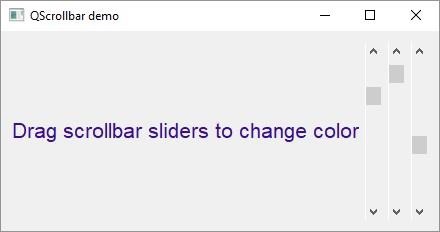
- PyQt5 - Home
- PyQt5 - Introduction
- PyQt5 - What’s New
- PyQt5 - Hello World
- PyQt5 - Major Classes
- PyQt5 - Using Qt Designer
- PyQt5 - Signals & Slots
- PyQt5 - Layout Management
- PyQt5 - Basic Widgets
- PyQt5 - QDialog Class
- PyQt5 - QMessageBox
- PyQt5 - Multiple Document Interface
- PyQt5 - Drag & Drop
- PyQt5 - Database Handling
- PyQt5 - Drawing API
- PyQt5 - BrushStyle Constants
- PyQt5 - QClipboard
- PyQt5 - QPixmap Class
- PyQt5 Useful Resources
- PyQt5 - Quick Guide
- PyQt5 - Useful Resources
- PyQt5 - Discussion
PyQt5 - QScrollBar Widget
A QScrollbar control enables the user to access parts of the document that is outside the viewable area. It provides visual indicator to the current position. It has a slider by which a value between a preset range is set in analogous fashion. This value is usually correlated to bring a hidden data inside the viewport.
The QScrollbar control has four controls −
|
a: slider b: Two Scroll arrows c: Page control |
Scroll Bar |
Following signals of QScrollBar class are frequently used −
| Sr.No. | Methods & Description |
|---|---|
| 1 |
valueChanged() When the scrollbars value changes |
| 2 |
sliderMoved() When the user drags the slider |
Example
In the following example, three scroll bars are placed to control RGB values of font color for the text displayed in a label. The complete code is as follows −
import sys
from PyQt5.QtCore import *
from PyQt5.QtGui import *
from PyQt5.QtWidgets import *
class Example(QWidget):
def __init__(self):
super(Example, self).__init__()
self.initUI()
def initUI(self):
vbox = QVBoxLayout(self)
vbox.addLayout(box)
self.setLayout(vbox)
hbox = QHBoxLayout()
self.l1 = QLabel("Drag scrollbar sliders to change color")
self.l1.setFont(QFont("Arial",16))
hbox.addWidget(self.l1)
self.s1 = QScrollBar()
self.s1.setMaximum(255)
self.s1.sliderMoved.connect(self.sliderval)
self.s2 = QScrollBar()
self.s2.setMaximum(255)
self.s2.sliderMoved.connect(self.sliderval)
self.s3 = QScrollBar()
self.s3.setMaximum(255)
self.s3.sliderMoved.connect(self.sliderval)
hbox.addWidget(self.s1)
hbox.addWidget(self.s2)
hbox.addWidget(self.s3)
self.setGeometry(300, 300, 300, 200)
self.setWindowTitle('QSplitter demo')
self.show()
def sliderval(self):
print self.s1.value(),self.s2.value(), self.s3.value()
palette = QPalette()
c = QColor(self.s1.value(),self.s2.value(), self.s3.value(),255)
palette.setColor(QPalette.Foreground,c)
self.l1.setPalette(palette)
def main():
app = QApplication(sys.argv)
ex = Example()
sys.exit(app.exec_())
if __name__ == '__main__':
main()
The above code produces the following output −
